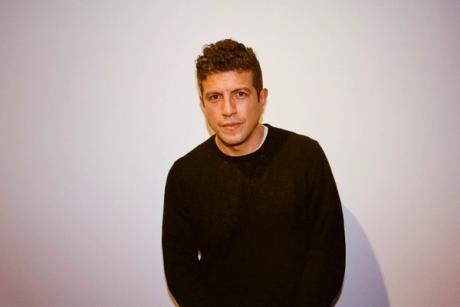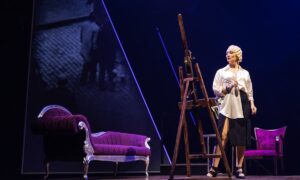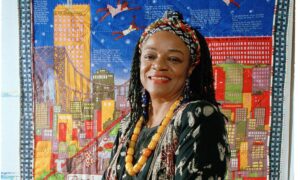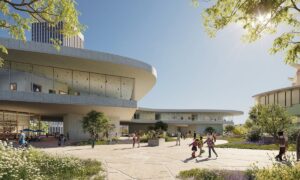[ad_1]

James Fuentes Gallery, long a forward-looking presence in the contemporary art scene on New York’s Lower East Side, is the latest space to decamp to Tribeca. Rather than an act of trend-following, however, Fuentes’s decision to relocate his headquarters to the bustling gallery district represents the natural next step for a dealer who has been dedicated to championing the creative ferment of downtown artists for nearly two decades.On 8 March, Fuentes inaugurated his new space at 52 White Street with Color Codes (until April 20), a solo exhibition of works by the late Japanese American artist Kikuo Saito (1939-2016). Curated by Christopher Y. Lew, it is the most extensive presentation to date of the artist’s Monochromatic series, made up of large-scale paintings executed between 1990 and 1993 at Saito’s first New York studio, located just six blocks away from the gallery’s latest address.“I really see Tribeca as Kikuo’s neighbourhood,” Fuentes tells The Art Newspaper, adding that these paintings “were produced on Chambers Street, so it felt like a very fitting opportunity to present these works in situ.”Building a historyThe gallery’s move from its home of 14 years, at 55 Delancey Street, represents a significant milestone for Fuentes, whose upbringing was split between the Lower East Side and the Bronx. Since establishing his eponymous space in 2007, he has been widely recognised for spotlighting an eclectic group of artists with practices outside the commercial conventions of the contemporary art market, with a special interest in the evolving legacy of downtown New York. The programme encompasses emerging and late-career artists who have been historically overlooked, from the 35-year-old conceptualist Amalia Ulman to the 80-year-old painter and printmaker Elsa Rensaa.Fuentes’s interest in curation was sparked as an undergraduate studying film-making and anthropology at Bard College in upstate New York from 1994 to 1998. There he was immersed in a community of artists and mentors and regularly frequented public lectures hosted by the school’s Center for Curatorial Studies, then in its early stages of development.“I kind of picked up this idea of curating as a profession through osmosis, studying adjacent to the Bard Center for Curatorial Studies and spending time in the library founded by Marieluise Hessel,” Fuentes says. “The programme planted a seed.”Upon returning to New York City after graduation, Fuentes observed many of his peers struggling to get their bearings and find venues to show their work. In this he saw an opportunity to apply his foundational knowledge of curation to support the creative community around him.“Right out of school, I had a very DIY mentality, and I was surrounded by all of these talented artists all of the time,” he says. “That really motivated me, and is kind of how it all began.”Kikuo Saito, Monk’s Pocket, 1990Courtesy of James Fuentes Gallery Mentorship mattersFuentes found an unexpected mentor early on in Jonas Mekas (1922-2019), the lauded experimental film-maker and co-founder of the Anthology Film Archives. Fuentes organised shows for Mekas around the globe on and off over a roughly 20-year period that began with a cold call to the artist in the late 1990s to pitch him on exhibiting in a 300 sq. ft storefront where Fuentes was also living at the time. Working with Mekas not only taught the budding gallerist how to present niche experimental works to contemporary art audiences but also informed his entire approach to the art world.“Mekas was generous, inclusive and would always go out of his way to introduce people to one another,” Fuentes says. “Observing the way he operated in his field was immensely informative for me.”After a few years of working with the seasoned gallerist Jeffrey Deitch and curating shows at Gavin Brown’s Enterprise, Fuentes opened a gallery under his own name in a two-storey building on Saint James Place in Chinatown in 2007. He faced his first major crisis soon after, when the Great Recession pilloried the art market and threatened Fuentes with the imminent closure of his business only one year after its opening. Yet the dealer was undeterred, as evidenced by an answer he recalls giving in a New York Magazine story asking what he would do if he were unable to sell work in the coming months.“Without even thinking about it, my reflex was to say that I would get another job to supplement financing the gallery,” says Fuentes. As inspiration, he cites another mentor, the longtime New York dealer Mitchell Algus, who worked for decades as a public school teacher in Queens while programming his own namesake commercial gallery during his off hours. “That allowed him to have a salary and also advocate for art that maybe wasn’t so obvious or easy to sell,” he adds. (Algus retired from teaching in 2014 but continues to operate the gallery.)Fuentes survived the recession and has gone on to thrive in the time since. After three years operating his original space, he set his sights on moving to a more central location. On the advice of the critic Roberta Smith, he upgraded to a new space at 55 Delancey Street, within walking distance of where he grew up on New York’s Lower East Side, in 2010. His steady success there eventually led to a bi-coastal expansion; Fuentes debuted a Los Angeles gallery in the burgeoning Melrose Hill neighbourhood in May 2023.Installation view of Kikuo Saito: Color Codes at James Fuentes GalleryCourtesy of James Fuentes Gallery‘Renovating’ and relocatingFuentes considers his programme a form of “renovating art history” by bringing artists from the fringes to the forefront. For example, last September in LA, the gallery presented Moving Through, the first solo exhibition in the city by the American feminist painter Juanita McNeely (1936-2023). The show centred on autobiographical works originating in her experiences with cancer and abortion before the latter’s legalisation in the US. Fuentes’s representation of McNeely propelled her to a new level of prominence, with the Whitney Museum of American Art and the Rubell Museum in Washington, D.C. acquiring her work.“I’m grateful for the fact that we’re in a moment now where society has shifted its priorities in terms of which artists are part of the dialogue, but there’s still so much work to be done,” Fuentes says.Fitting neatly into this framework is his decision to inaugurate the Tribeca location with a solo exhibition by Saito. The presentation underscores Fuentes’s dedication to showcasing both innovative, largely under-the-radar works, especially by artists informed by downtown New York, and the historical narrative of his surroundings. He identifies “being in direct dialogue [with] the locality of the gallery” as key to his programme’s identity, adding of his space’s latest migration: “I’m excited about the shifting context because there are new narratives and new blind spots that we’re able to discover and bring forth.”“For the first time ever in the history of the gallery, we’ll be centrally located and in the middle of the conversation,” he adds. “I feel like I owe it to the artists and the programme to be front and centre, and it seems like the appropriate time to do that.”
[ad_2]


























